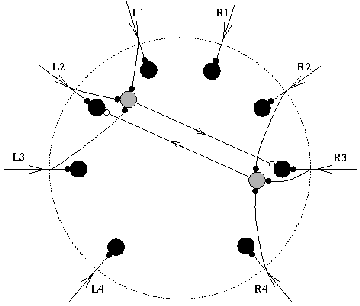
Under cover of darkness, a burrowing cockroach skitters across the desert sand. Its rapidly moving legs excite tiny ripples that travel along the ground, tipping off a lurking sand scorpion. Turning swiftly toward its prey, the scorpion darts forward with pincers outstretched, finally grabbing and stinging its victim.
How does the sand scorpion determine which way to turn? In effect, how does it figure out direction from waves traveling through the sand?
The sand scorpion (Paruroctonus mesaensis) inhabits the dunes of the Mojave Desert in California, feeding mainly on small insects and other scorpions. Researchers can readily observe its nocturnal habits because it fluoresces a brilliant yellow-green under ultraviolet light.
The sand scorpion uses two types of sensors on the tips of its legs to detect mechanical vibrations transmitted over relatively short distances across the surface. One sensor, called the basitarsal slit sensillum, detects surface waves, or ripples. The other type–consisting of numerous sensory hairs touching the surface–responds to compressional waves traveling through sand.
Researchers have knocked out the eight vibration sensors on a scorpion’s legs, one at a time or in certain patterns, to see how each one contributes to the scorpion’s computation of target location. Scorpions having just one or two intact sensors, for example, respond only in one direction–toward the leg with the functioning sensor.
Other experiments show that the timing of leg stimulation by a passing surface wave rather than the relative amplitude of movement is the cue that specifies target angle. A scorpion can tell when some of its sensors are stimulated as little as 0.2 millisecond before the others.
Physicist J. Leo van Hemmen of the Technical University of Munich in Germany and his coworkers have now developed a computational model of how a scorpion pinpoints its prey. They describe their theory in the June 12 Physical Review Letters.
Suppose that a burrowing cockroach is 90 degrees to the right of a scorpion. The surface waves generated by the cockroach’s footsteps pass beneath each of the scorpion’s eight points of contact with the ground. The array of sensors has a roughly circular configuration, so the leg nearest the source detects the wave first, followed by other legs in turn, finally reaching those farthest away on the opposite side of the array.
The sensor on the right leg nearest the source sends a signal to a network of neurons in the scorpion’s rudimentary brain, arranged in a circular pattern mimicking the sensory field. The theorists assume that spikes from all sensory neurons take the same amount to time to reach the brain’s command center and that eight “command neurons” encode the eight positions of the scorpion’s vibration sensors. They also posit that a signal excites not only a neuron corresponding to a vibration sensor but also a partner neuron, which sends an inhibitory signal to the neuron opposite it in the array. Similar inhibitory signals arrive from neurons associated with sensors on either side of the one initially excited.
“Because of the inhibitory triad, each command neuron has a time window during which it can respond to the stimulus,” the researchers say. “Each window is opened by the stimulus coming from its corresponding sensory input and closed by the inhibitory triad opposite to it.” The time window’s width determines a neuron’s firing probability.
In effect, the system ensures that the neuron corresponding to the vibration sensor on the leg nearest the source becomes most excited, whereas the neuron on the opposite side of the array barely fires, with a gradual decrease in activity across the ring from right to left. The resulting, lopsided neural activity turns a scorpion in the appropriate direction.
“The agreement [of the model] with behavioral experiments on sand scorpions is excellent,” van Hemmen remarks. Though quite simple, the mechanism is remarkably effective for solving the complex problem of snaring a midnight snack.






